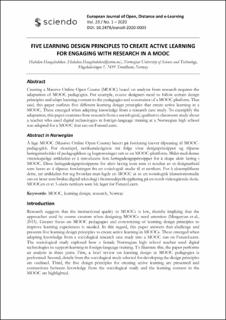| dc.contributor.author | Haugsbakken, Halvdan | |
| dc.date.accessioned | 2021-03-18T09:37:27Z | |
| dc.date.available | 2021-03-18T09:37:27Z | |
| dc.date.created | 2020-05-02T13:14:09Z | |
| dc.date.issued | 2020 | |
| dc.identifier.issn | 1027-5207 | |
| dc.identifier.uri | https://hdl.handle.net/11250/2734093 | |
| dc.description.abstract | Creating a Massive Online Open Course (MOOC) based on analysis from research requires the adaptation of MOOC pedagogies. For example, course designers need to follow certain design principles and adapt learning content to the pedagogies and constraints of a MOOC platform. That said, this paper outlines five different learning design principles that create active learning in a MOOC. These emerged when adapting knowledge from a research case study. To exemplify the adaptation, this paper examines how research from a sociological, qualitative classroom study about a teacher who used digital technologies in foreign-language training at a Norwegian high school was adapted for a MOOC that ran on FutureLearn. | en_US |
| dc.language.iso | eng | en_US |
| dc.publisher | Sciendo | en_US |
| dc.relation.uri | https://www.eurodl.org/?p=current&sp=full&article=833 | |
| dc.rights | Attribution-NonCommercial-NoDerivatives 4.0 Internasjonal | * |
| dc.rights.uri | http://creativecommons.org/licenses/by-nc-nd/4.0/deed.no | * |
| dc.title | Five Learning Design Principles to Create Active Learning for Engaging With Research in a MOOC | en_US |
| dc.type | Peer reviewed | en_US |
| dc.type | Journal article | en_US |
| dc.description.version | publishedVersion | en_US |
| dc.source.volume | 23 | en_US |
| dc.source.journal | European Journal of Open, Distance and E-Learning | en_US |
| dc.source.issue | 1 | en_US |
| dc.identifier.doi | 10.2478/eurodl-2020-0003 | |
| dc.identifier.cristin | 1809073 | |
| cristin.ispublished | true | |
| cristin.fulltext | postprint | |
| cristin.qualitycode | 1 | |

